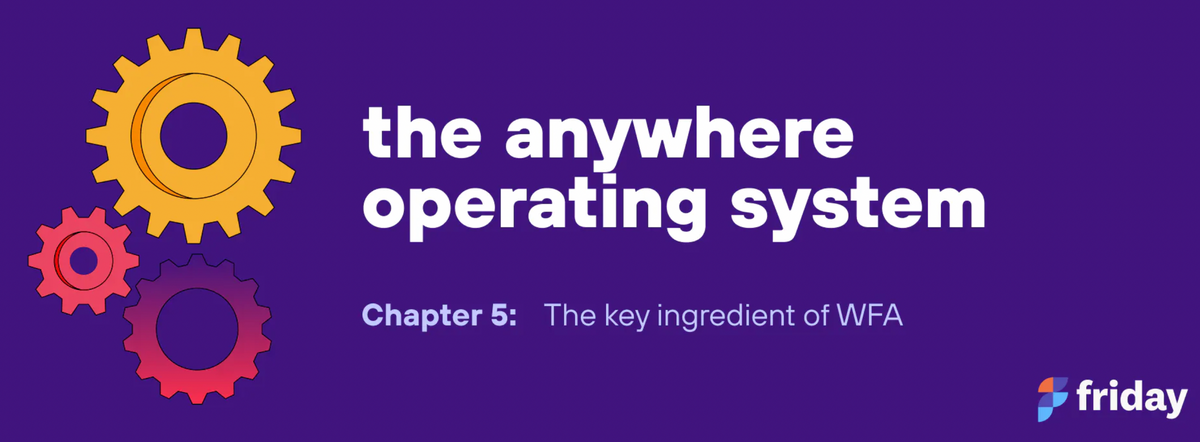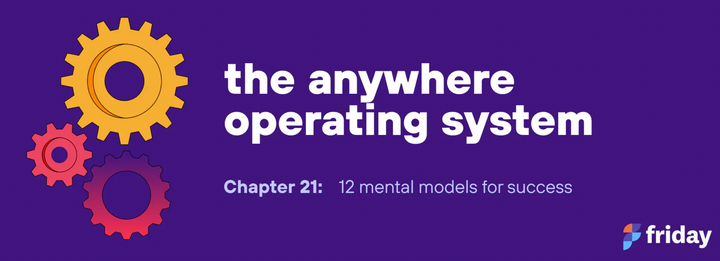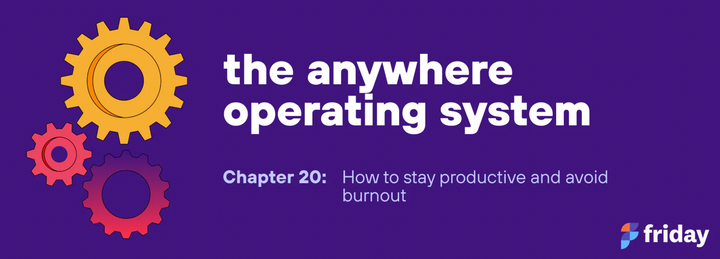Chapter 5: The #1 ingredient to working from anywhere

If the work-from-anywhere movement is about a more flexible work environment that gives the individual autonomy to decide when and where they work, we need to dig in and see what’s preventing us from making this change. This transition is still in its early innings for many of you, whether you realize it or not.
Unfortunately, the modern workplace is addicted to constant presence to move work forward. It looks like never-ending Zoom calls and constant chatter in Slack. If we want to build a future-proof team or company, we need to make some changes asap.
What's hindering the work-from-anywhere movement?
1. Habit
The first roadblock is that we are creatures of habit. The office encouraged constant collaboration and was intentionally built to maximize real-time interactions. Meetings were cheap and coordination was easy. When everyone was in the office at the same time, it was easy to find a coworker and ask them a question. Constant presence meant work was happening.
It turns out that office habits are difficult to change, especially with a group of people. It can be tough to reverse this gravitational pull as you try to make the shift to remote.
2. Unspoken expectations
The next contributor to a brittle work environment is unspoken expectations. You may be okay with the idea of a more flexible workplace for your team, but it’s possible you didn’t clarify and reinforce this idea enough, so your team still believes they need to be present from 9-5 p.m. People may worry that they might get into trouble if they go for a walk after lunch or finish their day a bit early to hang out with family or friends.
3. Meetings
According to Atlassian, the average employee has 61 meetings per month, with half of them considered to be a waste of time. The average middle manager spends up to 50% of their time in meetings. The average organization spends 15% of its time in meetings. If the average person spends almost one day every week in meetings, that creates a shaky foundation from the start.
While it’s impossible to eliminate all your meetings at work, especially with customers and external stakeholders, it is possible to dramatically reduce the amount of time you spend in them, especially if they are poorly run and ineffective. To illustrate, consider the dreaded status update meeting.

4. Workplace chat
Next up, we have workplace chat software. Like meetings, workplace chat is an effective way to collaborate and coordinate work with colleagues, but it assumes that we should collaborate all the time, which reminds me of the office at its worst. Too much of a good thing can be a bad thing!
To illustrate, Microsoft conducted research at the beginning of the pandemic showing that team leaders sent 115% more messages in Microsoft Teams than before COVID hit. We also can see a steady stream of articles that outline how workplace chat is overwhelming and functions like a never-ending treadmill, keeping us distracted and unable to do deep work.

According to RescueTime, of the time people spend working in front of a computer, 5% is spent using work chat. This software inadvertently creates an expectation that the recipient will reply right away. After all, that’s how chatting in the real world works! RescueTime research also shows that 40% of knowledge workers are unable to get 30 minutes of uninterrupted focused time in a workday because they are constantly interrupted by these tools.
That’s not all. Slack and Teams also project a constant state of presence, which is the digital equivalent to someone walking around and making sure you are sitting at your desk working. If someone is away from the computer, their status will automatically mark them as offline, which reinforces the “butts-in-seat” mentality that desperately needs to be changed in a work-from-anywhere model.
The issues with workplace chat tools have prompted remote-first companies like Zapier, Automattic, Stripe, and Shopify to create their own “intranet” to encourage slower and more thoughtful communication.
This pain is why I founded Friday. I find tools like Slack to be an essential piece of the work-from-anywhere software stack, but you need rules and logic to ensure that things don’t get out of hand.
Now that we understand the roadblocks in our way, let’s talk about the solution. But first, let’s talk about a big word that you need to know.
What is asynchronous communication?
Asynchronous communication is when two or more people communicate without the requirement that they be present at the same moment in time. For example, if I send you an email, you could read and reply at a time that makes sense for you. If I send you a handwritten letter in the mail, you can read it when it arrives, and reply at a time when it makes sense for you.
Asynchronous communication is a more flexible way to communicate because the sender and receiver don’t need to be present at the same time.
On the flip-side, if I wanted to jump on a Zoom call with you, we’d need to schedule a time where both of us can be present at once. If you can’t make it, communication does not happen. This is synchronous communication; it is not flexible by design because it requires all parties to be present. It’s a much more rigid way to communicate.
Why does asynchronous communication matter?
If you spend most of your work week in meetings or in chat (like research indicates), you have laid a foundation where the presence of others is required to move work forward. Every real-time conversation creates a potential blocker that will need to navigate. The more your day is spent working on someone else’s time and schedule, the more inflexible and brittle your workday becomes.
Meetings as the last resort, not the first option
To be clear, I am not advocating for ditching meetings and real-time human interaction completely. Instead, I believe that you should reduce your reliance on meetings and real-time communication to get work done, saving meetings for when they are most important.
When you worked at the office, the environment encouraged synchronous communication as the default. It was easier to hold meetings. You could walk up to a coworker and start a conversation right away. It was easy to have white-boarding sessions.
Now, the coordination cost is much higher when everyone is apart. It’s much more difficult to align schedules, especially with teams across time zones. As a result, it’s more practical to communicate asynchronously by default.
In fact, the longer a company works from anywhere, the more they want to communicate asynchronously by default.
Find the balance
Now, you will need to unlearn some of the habits that the office previously encouraged. You need to find a healthy balance between real-time conversations and asynchronous communication.
Each communication method is a tool in your WFA toolbox. There’s a time when it makes sense to jump on a Zoom call. There’s also a time when it makes sense to share an asynchronous update using a tool like Friday.
In the next chapter, we’re going to discuss the different communication tools at your disposal and when it makes sense to use them. It’s easy to say that the key to working from anywhere is to communicate asynchronously, but if we want to be successful, we need to translate this high-level idea into action.


